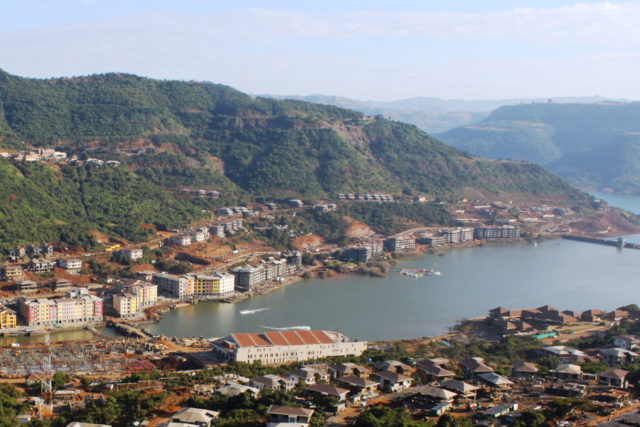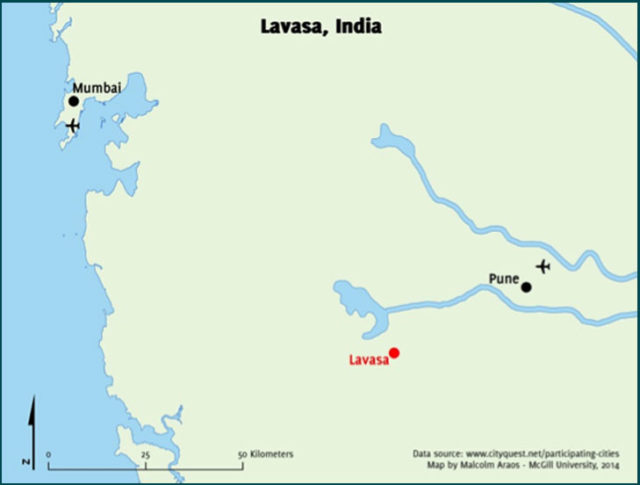India’s First Post-Independence Planned Hill City
December 11, 2014 — Blog
Lavasa is a private city located in a remote part of western India, 50 miles from Pune and close to the Pune-Mumbai corridor. As India’s first post-independence planned hill city, Lavasa follows the principles of new urbanism to prioritize walkable and accessible neighborhoods with a sustainable focus. 70% of the land is designated as natural landscape and 80% of the population will live and work in 20% of the land.
We marketed the city so people know they are getting something different. That said, you can push the envelope, but you can only push it so far. – Scot Wrighton, City Manager, Lavasa
The city is being built one section at a time so that potential residents and investors can get a feel for the completed city even while other sections are under construction. Lavasa seeks to become a replicable model that will serve as a template for the construction of other cities of this scale within India. Unlike many other new cities, Lavasa does not aim to appear modern; rather, it seeks to be a smart city that selectively uses technology to reduce waste and increase efficiency while maintaining the charm and human scale of historical cities.


Key Facts
Timeframe: 2004 – after 2020
Intended population: 300,000
Size: 100 square kilometers
Estimated cost: USD $7 billion at project completion.
Financing: Financial partners include the Lavasa Corporation, the Hindustan Construction Company, headed by Ajit Gulabchand, and HOK International Limited. Notably, Lavasa is not just a real estate venture; to date it has invested much more in infrastructure than in traditional real estate development. Over time, as the amount of real estate revenue decreases, earnings will come from operating revenues derived from various city facilities, partial ownership in Lavasa-based service businesses, and amenities in which Lavasa Corporation has invested to varying extents: marina facilities management companies, education, retail, hospitality, restaurants, and industrial laundry.
Planners / contractors: HOK created the master plan, and the initial infrastructure was built by Hindustan Construction Company.
Environmental and sustainability strategies:
- Seeks to reforest the area as a moist deciduous forest and restore the original ecosystem through mass planting, detailed landscaping, slope greening and hydro-seeding.
- Uses continuous contour trenching and experiments with ways to raise the water table.
- Aims to responsibly manage resources: Lavasa has a Green Building Certification (LEED-NC), an organic waste converter, city-wide vermicomposting, and uses soil biotechnology.
- Through recycling and education programs, Lavasa aims to reduce waste sent to landfills by 95%.
Industries: Lavasa seeks to attract non-polluting industries, including higher education, leisure and recreation, tourism, research centers, IT related businesses, and film facilities.
Energy sources: At the moment Lavasa is in partnership with MSEB and Tata Power to ensure uninterrupted electricity. The city plans to build facilities to harness wind and solar power as well as miniature hydro-electric dams to reduce its reliance on the grid.
Precedents: Lavasa employed urban design strategies from various European towns, including Portofino, Italy, which are dense, walkable and have a distinct, unified identity. The master plan also draws inspiration from traditional patterns of Indian town planning and vernacular forms of building.
Attractivity: The features intended to attract residents and businesses to Lavasa include features distinctly lacking in most current Indian cities: abundant access to nature, a cosmopolitan lifestyle, good schools, a functional and clean city, an uninterrupted power supply, high-speed internet, e-governance, drinkable tap water, and a walkable city in which the need for cars is minimal.
Local challenges: Although generally seen as a ground-breaking project, Lavasa has faced a myriad of government-related challenges:
- The primary challenge has been operating in a context in which there is little state planning. Working with the state of Maharashtra has presented a series of challenges for the progress of the city as the State’s municipal codes do not anticipate a private city like Lavasa.
- Another challenge has been striking a balance between forward thinking social and environmental policies and the need to attract residents whose expectations may not match this vision. For example, one challenge has been incentivizing people of vastly different socio-economic backgrounds to live in close quarters to one another when they would more typically be living physically separate lives in other cities.
- ‘Training’ the population to live a more sustainable lifestyle is an on-going challenge that requires culturally-appropriate education by the city. For example, separating garbage and recycling waste is a fundamental norm for any society that strives to be sustainable, but is a practice that is not common for many middle and upper class families in India.
- Trying to get the government not to think in a ‘one size fits all’ way in relation to urban development in India and trying to convince them that innovative urban approaches should be pursued.
This post is part of a series tied to Cityquest – KAEC Forum, our leadership event on new cities. Each week, we’ll publish extracts from the report from our inaugural Cityquest event in 2013. Access the full report here.